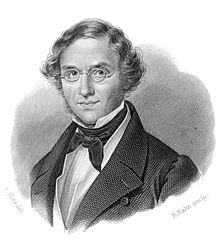Frédéric Dubois de Montpéreux
Frédéric Dubois de Montpéreux , also spelled Du Bois, in Russian Фредерик Дюбуа де Монпере , (born May 28, 1798 in Môtiers , today Canton Neuchâtel ; † May 7, 1850 in Peseux ) was a Swiss travel writer, naturalist, archaeologist and historian. He is known for his travelogue from the Caucasus .
life and work
He was actually only called Dubois, but after the homeland of his ancestors he added the name de Montpéreux. Dubois grew up in the vineyards on the shores of Lake Neuchâtel . His father was a businessman. He attended school in Neuchâtel and took an early interest in antiquities.
From 1817 to 1819 he was a French teacher in St. Gallen and then until 1821 private tutor ( Hofmeister ) in Courland . From 1821 to 1829 he was director of a school in Lithuania . During this time he also traveled to Poland , where he was also a tutor.
He went to Berlin with his students from 1829 to 1831 , where he heard lectures by well-known professors such as August Boeckh , Carl Ritter , Leopold von Buch and Alexander von Humboldt at the University of Berlin . From 1831 to 1834 he toured the Crimea and then the Caucasus . He was supported in this by the Russian government and the military, which was then just conquering the Caucasus.
He then published a multi-volume travelogue and received the gold medal of the French Geographical Society and the Order of St. Stanislaus from the Tsar and a large sum of money. The travelogue contains geographical, ethnographic and historical information as well as archaeological, geological and paleontological information and many drawings (he was a good painter).
He had an offer from the tsar to stay in Russia and travel there, but preferred to return to his homeland. Since it was founded in 1838, he taught archeology at the academy in Neuchâtel and became a professor there in 1843. When the academy closed in 1848, he continued to study the medieval monuments of Neuchâtel and the surrounding area, especially the collegiate church .
As an archaeologist, he dug in Cressier and Colombier , where he discovered a Roman villa.
He was friends with Ferdinand Keller and Arnold Escher von der Linth . He therefore donated his library and collections to the city of Zurich.
Fonts (selection)
- Conchiologie fossile et aperçu géognostique des formations du plateau Wolhyni-Podotien . Schropp, Berlin 1831 ( digitized version )
-
Voyage autour du Caucase, chez les Tscherkesses et les Abkhases, en Colchide, en Géorgie, en Arménie et en Crimée , 6 volumes, Librairie de Gide, Paris, 1839–1849, with additional atlas, ( digitized version )
- German: Journey around the Caucasus to the Circassians and Abkhazians, to Colchis, Georgia, Armenia and the Crimea . 3 volumes, Leske, Darmstadt 1842–1846 ( digitized version )
- La bataille de Granson . Zurich 1844
- Les monuments de Neuchâtel . Zurich 1852 ( digitized version )
Web links
- Denis Knoepfler : Frédéric Dubois de Montpéreux. In: Historical Lexicon of Switzerland .
- Curriculum vitae on the website of the Musée d'Ethnographie, Neuchâtel
- Russian website for his travelogue, Gelendzhik Museum
| personal data | |
|---|---|
| SURNAME | Dubois de Montpéreux, Frédéric |
| ALTERNATIVE NAMES | Montpereux, Frédéric Du Bois de; Dubois, Frédéric |
| BRIEF DESCRIPTION | Swiss travel writer, naturalist, archaeologist and historian |
| DATE OF BIRTH | May 28, 1798 |
| PLACE OF BIRTH | Môtiers |
| DATE OF DEATH | May 7, 1850 |
| Place of death | Peseux NE |
